Igneous Rocks
Steven Dutch, Professor Emeritus, Natural and Applied Sciences, University of Wisconsin - Green Bay
Igneous Rocks
Cool from the Molten State
- Volcanic -- Erupted on Surface
- Plutonic -- Solidify Within Earth
Large Grain Size ----> Slow Cooling
- Volcanic Rocks -- Fine Grained
- Plutonic Rocks -- Coarse Grained
Porphyritic Texture:
Large Crystals in Fine-grained Setting
- Slow Initial Cooling
- Rapid Final Cooling
Igneous Rock Classification
- How Much Silica?
Account for Si- Excess - Rock Has Quartz
- Just Enough to Form Other Silicates
- Deficient - Silica - Poor Minerals (Like Olivine)
- What Feldspars?
Account for Al, Ca, K, Na- Potash Feldspar KAlSi3O8
- Plagioclase Series
NaAlSi3O8......CaAl2Si2O8
- What Other Minerals Are Present?
Account for Fe, Mg
Feldspars
K - Feldspar:
KAlSi3O8: Several Slightly Different Forms:
- Microcline
- Orthoclase
Plagioclase (Solid Solution)
- Albite: NaAlSi3O8
- Anorthite: CaAl2Si2O8
- Any Mixture of the Two Is Possible
Bowen's Reaction Series
The geologist N.L. Bowen found that minerals tend to form in specific sequences in igneous rocks, and these sequences could be assembled into a composite sequence. 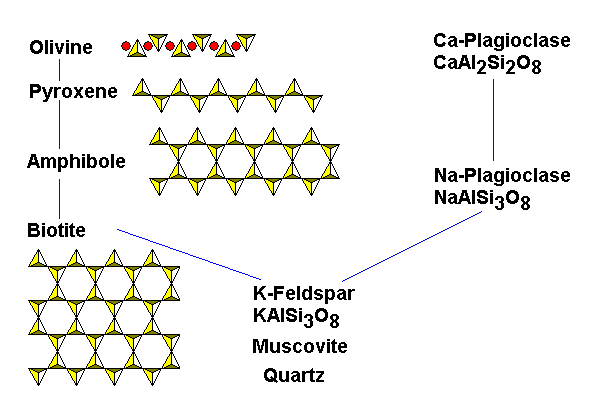
No igneous rock ever displays the whole sequence. Igneous rocks display a slice across the sequence. Basalt, for example, typically has olivine and calcium plagioclase forming first, followed by pyroxene and more sodium-rich plagioclase. In granite, sodium plagioclase and biotite typically form first, followed by muscovite, potassium feldspar, and last of all quartz. The sketch below turns the series on its side. It's actually a more realistic view since successive minerals often form simultaneously.
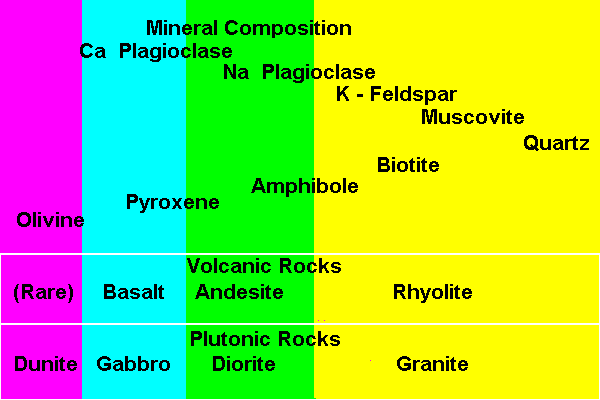
Bowen's Series and Igneous Rocks
| Mineral Composition | ||||
| Ca Plagioclase | Na Plagioclase | K - Feldspar | Muscovite | |
| Quartz | ||||
| Olivine | Pyroxene | Amphibole | Biotite | |
| Volcanic Rocks | ||||
| (Rare) | Basalt | Andesite |
Rhyolite |
|
| Plutonic Rocks | ||||
| Dunite | Gabbro | Diorite | Granite | |
| 1200 C | Melting Point | 700 C | ||
| Heavy | Density | Light | ||
| Mg, Fe | Rich In... | Si, Na, K | ||
| Fluid | Lava Is... | Viscous | ||
| Mild | Eruptions | Violent | ||
| Type of Volcano | ||||
| Shield Volcano | Stratovolcano |
Plug Dome |
||
| Rapid | Weathering | Slow | ||
| Usually Dark | Color | Often Light | ||
Some Igneous Rocks Are Named on Textural Criteria:
- Scoria: Porous
- Pumice
- Obsidian - Glass
- Tuff - Cemented Ash
- Breccia - Cemented Fragments
- Pegmatite - Extremely Large Crystals
- Aplite - Sugary Texture, Quartz & Feldspar
- Porphyry - Fine Matrix, Large Crystals
Types of Volcanoes
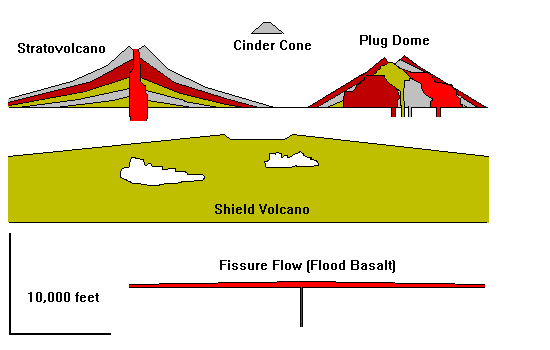
Products of Eruptions
- Lava Flows
- Pyroclastic Debris
- Bombs
- Lapilli
- Ash
- Mudflows
- Gases
- Steam
- Carbon Dioxide
- H2S
- SO2
- HCl
- HF
Environmental Hazards of Volcanoes
- Pollution
- SO2, HCl in Water
- Ash Falls
- Building Collapse
- Crop Destruction
- Mudflows
- Direct Damage (Colombia, 1985)
- Floods (Several Types)
- Lava Flows
- Falling Ejecta
- Blast (Mt. St. Helens, 1980)
- Nuee Ardente (St. Pierre, 1902)
- Gas (Lake Nyos, Cameroon, 1986)
Greatest Earthquakes and Volcanic Eruptions
Nuee Ardente (French: Fiery Cloud) or Pyroclastic Flow
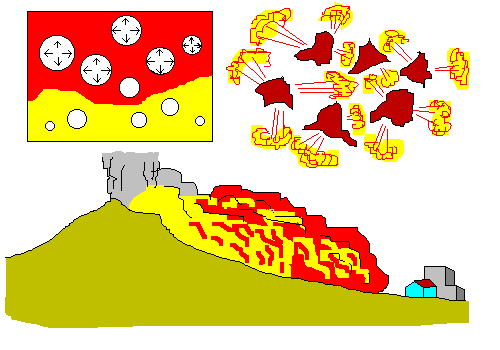
- Gas Expands as Lava Rises
- Lava Breaks up into Fragments Supported by Escaping Gas
- Cloud Flows Downhill at 60-100 M.p.h. Temperature about 1000 C
How Calderas Form
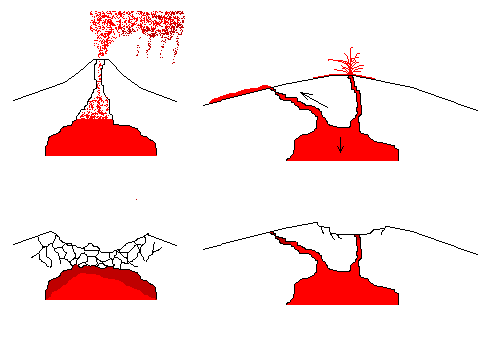
Calderas form when volcanoes collapse. In some cases, violent explosive eruptions (left) can empty a magma chamber enough that the summit collapses. In other cases, magma may erupt on the flanks of a volcano or drain back to deeper levels, permitting the summit to subside (right). These caldera collapses are generally not violent.
Evolution of Volcanoes
An active volcanic landscape
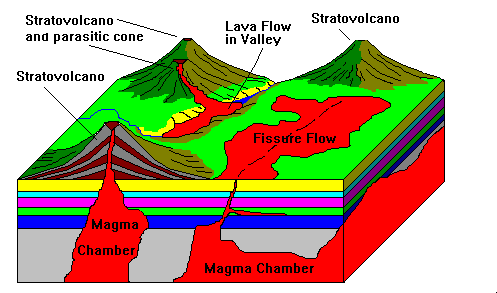
A volcanic landscape after a million years or so
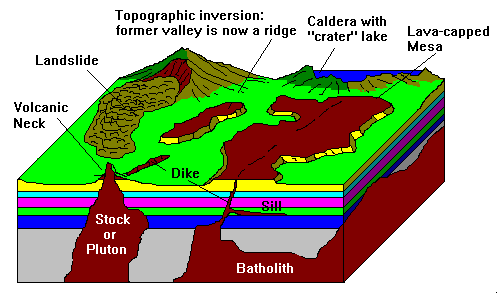
This figure shows some of the things that can happen to a volcanic area over time:
- Erosion of a volcano, leaving solidified magma in the conduit as a volcanic neck.
- Collapse of a volcano in a catastrophic landslide, now recognized as a common event in the lives of volcanoes.
- Collapse of a volcanic summit to form a caldera and perhaps a "crater" lake.
- Erosion to leave lava-capped hills as mesas, or former valley-filling flows as ridges.
Intrusions
Principal Types of Intrusion
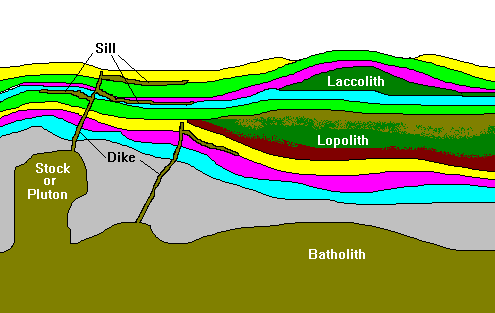
Tabular and Irregular Intrusions
Tabular intrusions are sheetlike, and consist of dikes and sills. All others are irregular.
Concordant versus Discordant Intrusions
Concordant intrusions are parallel to layers in the rocks
- Sills are thin sheets of magma between layers.
- Laccoliths are blister-like intrusions, usually near the surface, that form when magma pushes overlying layers upward.
- Lopoliths are mega-sills, usually of gabbro or diorite, that may cover hundreds of square kilometers and be kilometers thick. They often have a concave structure and are differentiated. That is, they take so long to harden that heavy minerals have a chance to sink and light minerals can rise.
Discordant intrusions cut across layers.
- Dikes are thin sheets of magma intruded into fractures in the crust.
- Stocks or plutons are small irregular intrusions
- Batholiths are usually granitic and cover hundreds or thousands of square kilometers.
Structure of Batholiths
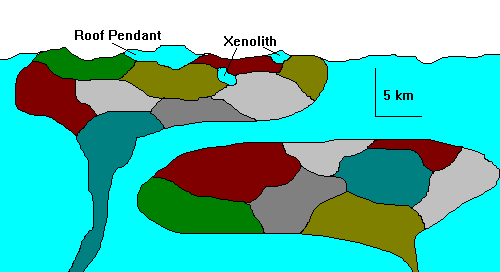
In the above diagram, non-batholithic rocks are shown in light blue.
Geological cross-sections often show batholiths as extending downward indefinitely. In fact, geophysical techniques and field observations suggest that most batholiths are thick lenses 10 km thick or so. Many batholiths have some of the former roof rocks still present as roof pendants. Isolated masses of rock that were trapped in the magma are called xenoliths (Greek for "foreign stone"). Most batholiths are composite and actually composed of many smaller intrusions, as shown here.
:Return to Physical Geology Notes Index
:Return to Professor Dutch's home page
Created 3 Feb 1997, Last Update 18 Sep 1997